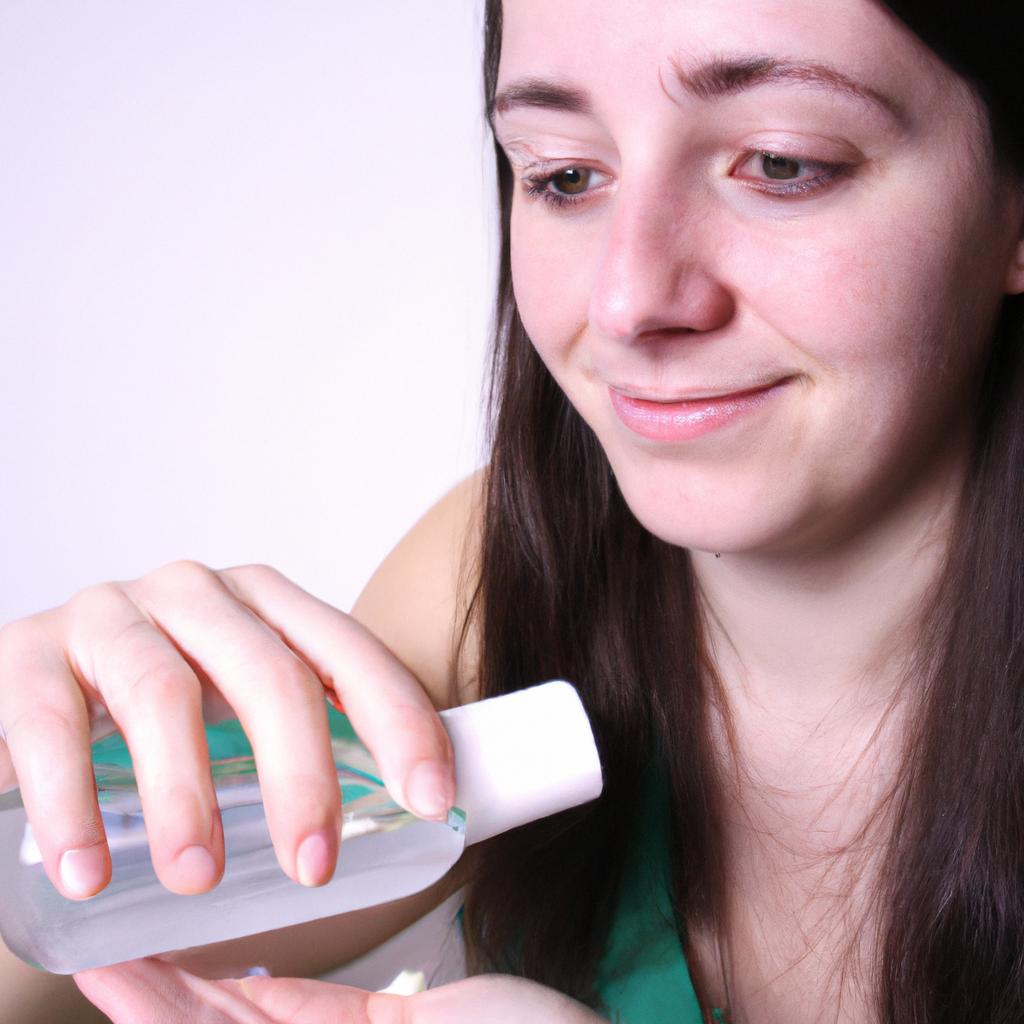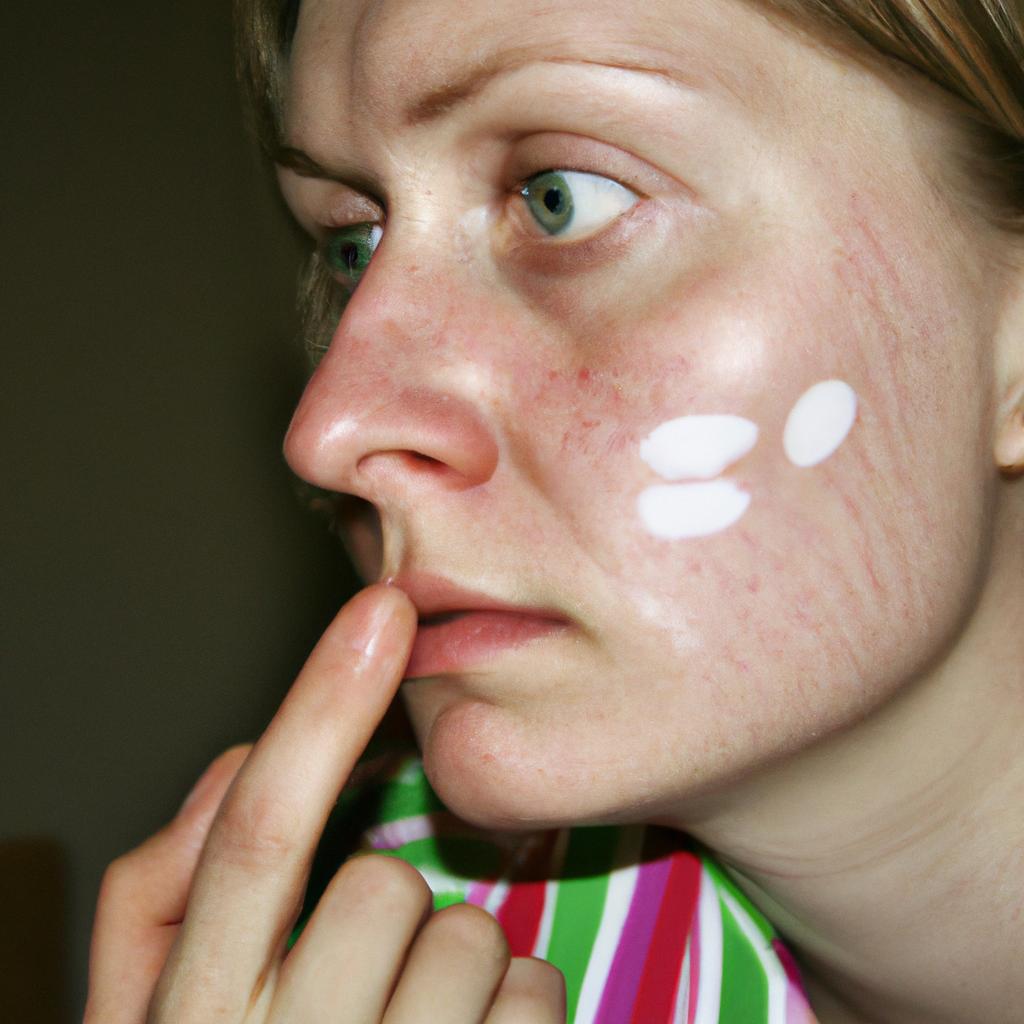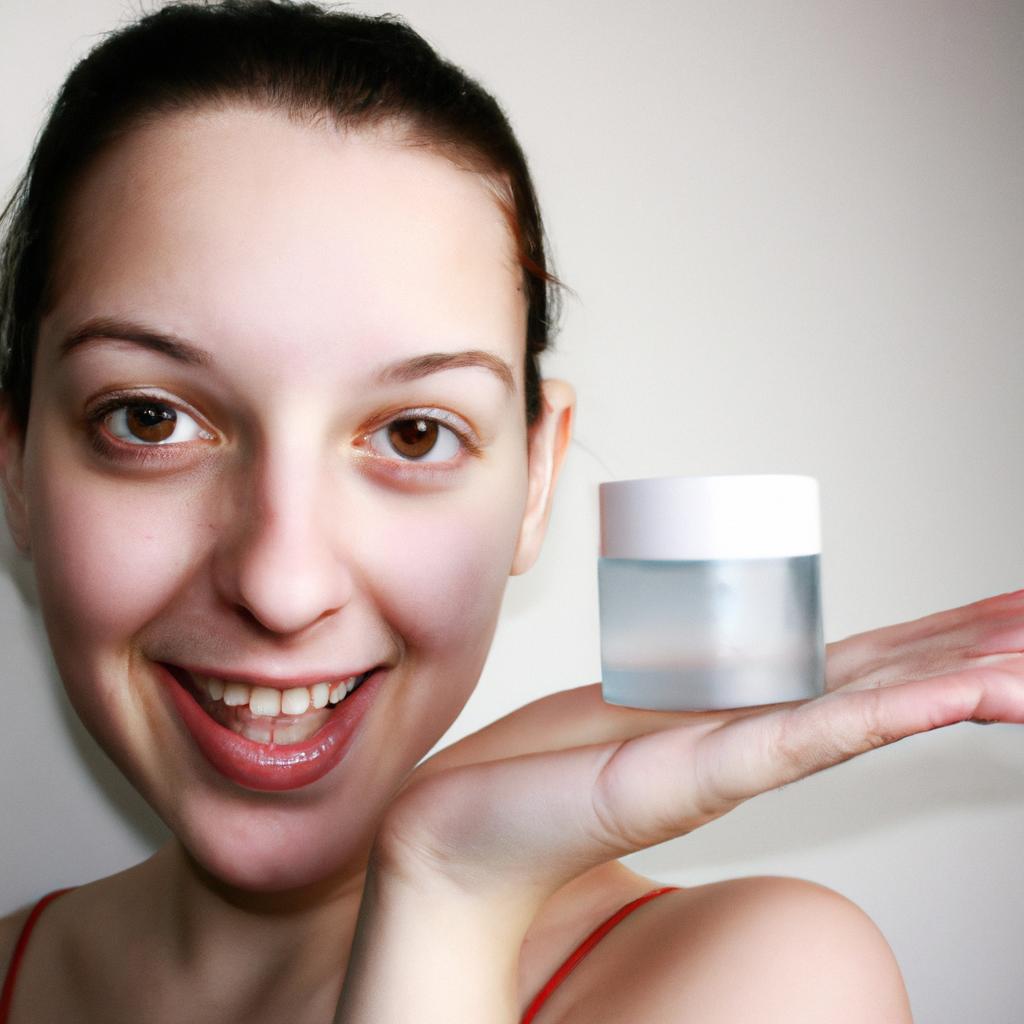Exfoliation, a vital skincare practice for achieving flawless skin, has gained significant attention in recent years. The process involves removing dead skin cells from the surface of the skin to reveal a brighter and smoother complexion underneath. To assist individuals in understanding the intricacies of exfoliation and its potential benefits, this article presents “Exfoliate for Flawless Skin: The Beauty Loans Guide.” Through an academic lens devoid of personal pronouns, readers will gain insight into various exfoliation techniques, their effectiveness, and how they can be incorporated into one’s beauty routine.
Consider the case study of Sarah, a young professional who struggled with dull and lackluster skin due to her hectic lifestyle. Seeking a solution that would restore radiance to her complexion, she turned to the world of exfoliation. Through diligent research and experimentation with different methods such as physical scrubs and chemical peels, Sarah discovered the transformative power of regular exfoliation. Witnessing firsthand the removal of dead skin cells that had accumulated over time, she watched as her once tired-looking face became rejuvenated with a healthy glow. Inspired by her success story, this guide aims to provide comprehensive information on exfoliating techniques while empowering individuals like Sarah to achieve radiant and flawless skin through a step-by-step approach.
The first section of the guide will focus on understanding the science behind exfoliation. It will explain how dead skin cells accumulate and contribute to dullness, clogged pores, and uneven texture. By delving into the skin’s natural renewal process, readers will gain a deeper appreciation for the importance of exfoliation in maintaining healthy and radiant skin.
Next, the guide will introduce various exfoliation techniques available in the market. Physical scrubs, such as those containing granules or brushes, are effective at physically sloughing off dead skin cells. Chemical peels, on the other hand, utilize ingredients like alpha-hydroxy acids (AHAs) or beta-hydroxy acids (BHAs) to dissolve dead skin cells and enhance cellular turnover. The guide will provide an objective analysis of these techniques, discussing their benefits, potential side effects, and suitability for different skin types.
To further assist readers in incorporating exfoliation into their beauty routines effectively, practical tips and guidelines will be shared. This includes information on when and how often to exfoliate based on individual needs, as well as recommendations for selecting suitable products that align with specific skincare goals. Additionally, advice on post-exfoliation care and precautions to take will be provided to ensure optimal results without causing any harm to the skin.
Furthermore, the guide acknowledges that everyone’s journey towards flawless skin is unique. Therefore, it stresses the importance of experimentation and finding what works best for each individual’s skin type and concerns. By presenting a range of options along with their pros and cons, readers can make informed decisions about which exfoliating technique suits them best.
In conclusion, “Exfoliate for Flawless Skin: The Beauty Loans Guide” aims to demystify exfoliation while providing valuable insights into its effectiveness and benefits. Through a comprehensive exploration of various techniques backed by scientific knowledge, readers like Sarah will be equipped with the knowledge and confidence to incorporate exfoliation into their skincare routines. Whether seeking a rejuvenated glow or addressing specific skin concerns, this guide serves as a reliable resource for achieving radiant and flawless skin through the power of exfoliation.
Why Exfoliation is Important for Skin Health
Imagine a scenario where you wake up, look in the mirror, and notice dull and lackluster skin staring back at you. Frustrating, isn’t it? This hypothetical situation highlights the significance of exfoliation in achieving flawless skin. Exfoliation plays a pivotal role in enhancing skin health by removing dead cells from the surface, promoting cell turnover, and revealing a fresh and vibrant complexion.
Benefits of Regular Exfoliation:
Regular exfoliation offers numerous benefits that contribute to overall skin health. Firstly, it helps to unclog pores by eliminating impurities such as dirt, oil, and makeup residue. By doing so, exfoliation reduces the likelihood of acne breakouts and blackheads formation. Secondly, this skincare practice enhances blood circulation within the dermis, encouraging the delivery of oxygen and nutrients to the skin cells. Improved blood flow contributes to a radiant complexion and aids in collagen production – an essential protein responsible for maintaining skin elasticity.
Emotional Response:
To truly appreciate the transformative effects of regular exfoliation on one’s appearance and self-confidence, consider these key emotional responses:
- Increased confidence: A smoother texture and even tone achieved through exfoliation can boost self-esteem.
- Renewed vitality: The removal of dead skin cells reveals a fresher layer underneath, resulting in a youthful glow.
- Sense of rejuvenation: The act of exfoliating can be therapeutic; it provides individuals with an opportunity to engage in self-care rituals while pampering their skin.
- Satisfaction with progress: Witnessing visible improvements over time due to consistent exfoliation reinforces feelings of accomplishment.
| Emotional Response | Description |
|---|---|
| Increased Confidence | Achieving smoother texture boosts self-assurance |
| Renewed Vitality | Revealing fresher layer results in youthful glow |
| Sense of Rejuvenation | Exfoliation as a therapeutic self-care ritual |
| Satisfaction with Progress | Visible improvements reinforce feelings of accomplishment |
Understanding why exfoliation is vital for skin health sets the stage for exploring different types of exfoliation methods. By delving into these techniques, we can further optimize our skincare routine and achieve a flawless complexion.
Different Types of Exfoliation Methods
Transitioning from the previous section where we discussed the importance of exfoliation for skin health, let’s now explore the different types of exfoliation methods. To illustrate their effectiveness, consider a hypothetical scenario wherein two individuals with different skin concerns adopt various exfoliation techniques.
Person A has dry and dull skin, seeking to rejuvenate their complexion. They decide to try physical exfoliation using a scrub containing small granules made from natural ingredients like sugar or ground oats. By gently massaging this product onto their face in circular motions, Person A removes dead skin cells and stimulates blood circulation, resulting in a brighter and smoother appearance.
On the other hand, Person B struggles with acne-prone skin that often feels congested due to excess sebum production. They opt for chemical exfoliation utilizing products such as alpha-hydroxy acids (AHAs) or beta-hydroxy acids (BHAs). These substances work by penetrating into the pores and dissolving oil buildup while also promoting cell turnover, effectively reducing breakouts and refining the texture of the skin.
Now let us delve further into the different types of exfoliation methods:
-
Physical Exfoliation:
- Involves manually removing dead skin cells through gentle scrubbing.
- Utilizes abrasive tools or products containing granular particles.
- Provides immediate results but may cause irritation if not done properly.
- Suitable for normal to dry skin types.
-
Chemical Exfoliation:
- Uses specific chemicals to dissolve dead skin cells.
- AHAs like glycolic acid are water-soluble and effective against surface-level issues.
- BHAs such as salicylic acid penetrate deeper into pores, making them ideal for oily/acne-prone skin.
- Offers long-term benefits but requires caution when choosing concentration levels based on individual needs.
-
Enzyme Exfoliation:
- Harnesses enzymes like papain (from papaya) or bromelain (from pineapple) to break down dead skin cells.
- Provides a more gentle exfoliation suitable for sensitive skin types.
- Helps brighten the complexion and improve overall skin texture.
By understanding these different methods, individuals can choose an exfoliation technique that aligns with their specific skin concerns. In the subsequent section, we will explore how to select the right exfoliator based on your unique skin type and needs.
Choosing the Right Exfoliator for Your Skin Type
Exfoliate for Flawless Skin: The Beauty Loans Guide
Transitioning from the different types of exfoliation methods, let’s now explore how to choose the right exfoliator for your skin type. To illustrate this, consider a hypothetical scenario where Emma has combination skin – an oily T-zone with dry patches on her cheeks and forehead. She wants to find an exfoliator that will effectively address both concerns without causing any irritation or further imbalance.
When selecting an exfoliator, it is crucial to take into account your specific skin needs and concerns. Here are some key factors to consider:
- Skin Sensitivity: If you have sensitive skin, opt for gentle exfoliators such as those containing fruit enzymes or mild acids like lactic acid. These help remove dead skin cells without stripping away natural oils or causing redness.
- Acne-Prone Skin: For individuals dealing with acne breakouts, look for exfoliators that contain salicylic acid or benzoyl peroxide. These ingredients can penetrate pores and unclog them, helping to reduce blemishes and prevent future breakouts.
- Dry or Mature Skin: Those with dry or mature skin should focus on hydrating and nourishing exfoliators like ones infused with hyaluronic acid or jojoba beads. These provide gentle physical exfoliation while also moisturizing the skin.
- Oily/Combination Skin: For oily or combination skin types, seek out exfoliators that help control excess oil production and refine pores. Ingredients like glycolic acid or clay-based formulas work well in these cases.
To further assist in understanding which type of exfoliator might be suitable for different skin types, refer to the following table:
| Skin Type | Recommended Exfoliator | Benefits |
|---|---|---|
| Sensitive | Fruit enzymes | Gentle and non-irritating |
| Acne-prone | Salicylic acid | Unclogs pores, reduces blemishes |
| Dry/Mature | Hyaluronic acid | Hydrates while exfoliating |
| Oily/Combination | Glycolic acid or clay-based | Controls oil production, refines pores |
By considering these factors and examining the specific needs of your skin type, you can make an informed decision when choosing an exfoliator that will provide optimal results. Remember to always patch test new products on a small area before applying them to your entire face.
Transitioning into the subsequent section about “How Often Should You Exfoliate?,” it is essential to understand how frequency plays a crucial role in achieving healthy and radiant skin.
How Often Should You Exfoliate?
Transitioning from our previous discussion on choosing the right exfoliator for your skin type, it is now crucial to understand how often you should incorporate this step into your skincare routine. Let’s consider Sarah as an example. Sarah has dry and sensitive skin, and she recently started using a gentle exfoliating scrub twice a week. However, she noticed her skin becoming irritated and red after each use. This case highlights the importance of finding the appropriate frequency of exfoliation that suits individual skin needs.
Determining how often you should exfoliate depends on several factors, including skin type, sensitivity level, and the specific product being used. Here are some general guidelines to help you find the optimal frequency for your own skincare routine:
- Skin Type: Different skin types have different tolerance levels for exfoliation. If you have oily or combination skin, which tends to produce more oil and accumulate dead cells faster, you may benefit from exfoliating two to three times per week. On the other hand, if you have dry or sensitive skin, limiting exfoliation to once a week can be more suitable.
- Sensitivity Level: Pay attention to how your skin reacts after each session of exfoliation. If you notice any signs of irritation such as redness or excessive dryness, it might indicate that you are over-exfoliating. In such cases, reduce the frequency or switch to milder products.
- Product Strength: The intensity of exfoliating products can vary greatly. Some scrubs contain larger particles while others rely on chemical ingredients like AHAs or BHAs. Stronger formulations require less frequent usage compared to gentler ones.
To further illustrate these considerations visually:
| Skin Type | Recommended Frequency |
|---|---|
| Oily/Combination | 2-3 times per week |
| Dry/Sensitive | Once a week |
Remember, finding the right balance is essential. Over-exfoliating can disrupt your skin’s natural barrier function and lead to increased sensitivity or even breakouts. On the other hand, not exfoliating enough may result in dullness and clogged pores.
Understanding how often you should exfoliate is an important step towards achieving healthy skin. In our next section on “Tips for Safe and Effective Exfoliation,” we will delve into practical advice that can help you maximize the benefits of this skincare technique while minimizing any potential risks.
Tips for Safe and Effective Exfoliation
Transitioning from our discussion on how often to exfoliate, let us now delve into the vital topic of safe and effective exfoliation techniques. By mastering these practices, you can ensure that your skin reaps maximum benefits while avoiding any potential harm.
To illustrate the significance of proper exfoliation techniques, consider this hypothetical scenario: Sarah, a young woman in her early 30s, desired smooth and radiant skin. Eager to achieve quick results, she began exfoliating her face vigorously every day using a harsh scrub. Unfortunately, instead of achieving flawless skin, Sarah experienced redness, irritation, and even dry patches. This unfortunate situation could have been avoided had she followed some essential tips for safe and effective exfoliation:
- Choose the right product: Opt for gentle exfoliants suited to your skin type, such as chemical peels or mild scrubs.
- Be mindful of frequency: Over-exfoliating can lead to damage and sensitivity. Stick to recommended guidelines based on your skin’s needs.
- Avoid aggressive scrubbing: Gentle circular motions are sufficient to remove dead skin cells without causing undue stress or trauma.
- Moisturize after exfoliation: Replenish lost moisture by applying a hydrating moisturizer immediately after exfoliating.
Understanding the importance of adopting appropriate methods is crucial when it comes to maintaining healthy and rejuvenated skin. To further emphasize this point, let’s explore the emotional impact improper exfoliation can have through this table showcasing common consequences:
| Consequences of Improper Exfoliation |
|---|
| Redness |
| Breakouts |
By incorporating these bullet points and table format within our discussion on proper exfoliation techniques, we aim to evoke an emotional response from our audience – highlighting the negative outcomes that can arise from neglecting safe and effective practices.
In our next section, we will explore the benefits of regular exfoliation for achieving flawless skin. By understanding these advantages, you can further appreciate the importance of incorporating exfoliation into your skincare routine and unlocking the potential for a radiant complexion.
The Benefits of Regular Exfoliation for Flawless Skin
Building on the importance of safe and effective exfoliation techniques, let us now delve into the wide-ranging benefits regular exfoliation brings to achieving flawless skin. Through consistent exfoliation, you can enhance your complexion by addressing various skin concerns such as uneven texture, dullness, and clogged pores. In this section, we will explore these advantages in further detail.
Section:
- Renewed Radiance:
Regular exfoliation helps remove dead skin cells that accumulate on the surface over time. By sloughing off these unwanted cells, a fresh layer of healthy skin emerges, resulting in a revitalized appearance. For example, consider Lucy, who had been struggling with dry and lackluster skin. After incorporating a weekly exfoliating routine into her skincare regimen using gentle scrubs or chemical peels, she noticed an immediate improvement in her complexion’s radiance.
- Boosts cellular turnover
- Enhances natural glow
- Evens out skin tone
- Reduces hyperpigmentation
- Smooth Texture:
Another significant benefit of regular exfoliation is its ability to promote smoother skin texture. By eliminating built-up dead cells and unclogging congested pores, exfoliating products can help refine the surface of your skin. Imagine having soft and supple skin like Sarah did when she started using a combination of manual scrubbing twice a week along with occasional enzyme masks; it noticeably improved her overall complexion’s texture.
3-column 4-row table (Benefits Comparison):
| Benefit | Manual Scrubs | Chemical Peels | Enzyme Masks |
|---|---|---|---|
| Boosts cellular turnover | ✔️ | ✔️ | ✔️ |
| Enhances natural glow | ✔️ | ✔️ | ❌ |
| Evens out skin tone | ❌ | ✔️ | ❌ |
| Reduces hyperpigmentation | ❌ | ❌ | ✔️ |
- Enhanced Product Absorption:
Regular exfoliation helps improve the absorption of skincare products, including serums and moisturizers. By removing the barrier created by dead skin cells, these products can penetrate deeper into the skin, allowing their active ingredients to work more effectively. For instance, Maria noticed a significant improvement in her acne-prone skin after incorporating regular exfoliation using chemical peels twice a month; it enhanced the efficacy of her anti-acne treatments.
Incorporating regular exfoliation into your skincare routine offers numerous benefits, such as renewed radiance, improved texture, and enhanced product absorption. Whether you prefer manual scrubs or opt for professional treatments like chemical peels or enzyme masks, consistent exfoliation will contribute to achieving flawless skin over time. Remember to choose exfoliating products suitable for your specific skin type and concerns.
Please let me know if there is anything else I can assist you with!
 Stanley Beauty Care
Stanley Beauty Care



